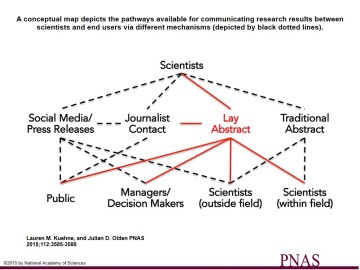It’s said that many hands make light work, but could that be true for science communication too? In an opinion piece in PNAS that came out last week (Kuehne and Olden 2015 http://www.pnas.org/content/112/12/3585.full ), we propose that lay summaries – published online alongside traditional abstracts – are an efficient and needed science communication option in a changing media landscape. Communication of research is undergoing radical and rapid change through ever-increasing reliance on the internet, resulting in a shift from traditional top-down knowledge transfers to a “media ecosystem” (see figure below). Within this ecosystem, widespread adoption of lay summaries could substantially bolster current science communication efforts by creating reliable and direct pathways between scientists and diverse audiences including journalists, policymakers, resource managers, and the general public. We argue that it wouldn’t hurt interdisciplinary communication between scientists either! 
Although lay summaries should enhance science communication across all disciplines, the need for broadly accessible research results is paramount in ecology and the environment. So we are taking this opportunity to urge journal editors and publishers in these fields to provide the platform for publication and incorporate requirement of lay summaries into their peer-review process. If you support the inclusion of online lay summaries we hope that you’ll join us in signing an open letter http://washington.co1.qualtrics.com/jfe/form/SV_bQIXBWeha7Aeahv to major ecology and environmental journals which will be sent on April 10th.
Thanks!
Lauren Kuehne and Julian Olden
University of Washington School of Aquatic and Fishery Sciences


You must be logged in to post a comment.